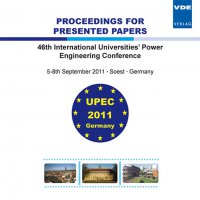An investigation of the power consumption and quality of supply for lighting technologies used in industrial energy-efficient initiatives
Konferenz: UPEC 2011 - 46th International Universities' Power Engineering Conference
05.09.2011 - 08.09.2011 in Soest, Germany
Tagungsband: UPEC 2011
Seiten: 6Sprache: EnglischTyp: PDF
Persönliche VDE-Mitglieder erhalten auf diesen Artikel 10% Rabatt
Autoren:
Jakoef, A. (Stellenbosch University, South Africa)
Vermeulen, H.J.
Inhalt:
The South African electricity utility company, Eskom, is driving energy-efficient initiatives in an attempt to reduce the demand on the energy grid of the country. Energyefficient lighting projects form a major part of these initiatives in South Africa. Energy-efficient lighting projects involve the exchange of one type lighting technology for another more energy-efficient lighting technology. The process involves a proposal from an energy services company to replace one type of lighting technology with another on the property of a third party, the client. In the industrial sector a typical energyefficient lighting project involves the retrofit of high intensity discharge lamps with tubular fluorescent lamps. When calculating the viability of such a project, energy services companies perform energy savings calculations based on information obtained from the datasheet sources. The effect on the energy consumption of these lighting technologies as a result of changes in the supply voltage is rarely illustrated in datasheets. Furthermore, energy-efficient lighting technologies such as tubular fluorescent lamps employ power electronic circuitry that can in principle give rise to quality of supply problems such as harmonic distortion. In view of these considerations a laboratory investigation is conducted to address the lack energy consumption data with regard to the changes in supply voltage, and to determine the quality of supply impacts for all relevant lighting technologies namely tubular fluorescent lamps and high intensity discharge lamps. The energy consumption based on changes in the supply voltage is mathematically modelled for these lighting technologies. The models are derived from laboratory measurements. The harmonic distortion of the supply current for the various lamp types are investigated, particularly with regard to neutral current loading caused by zero-sequence harmonics.


